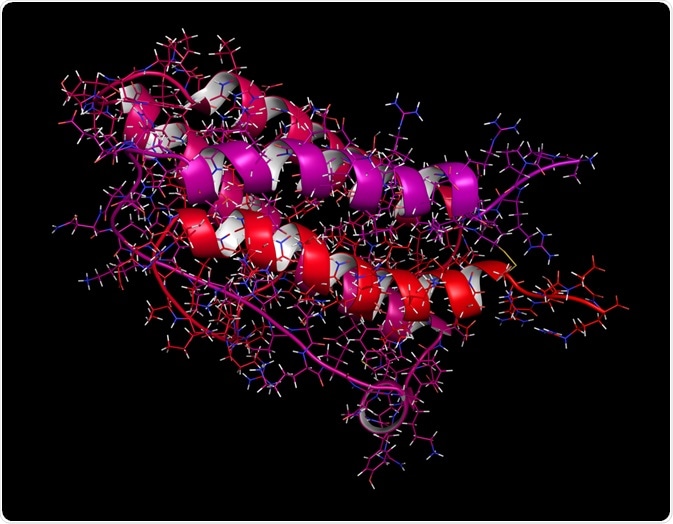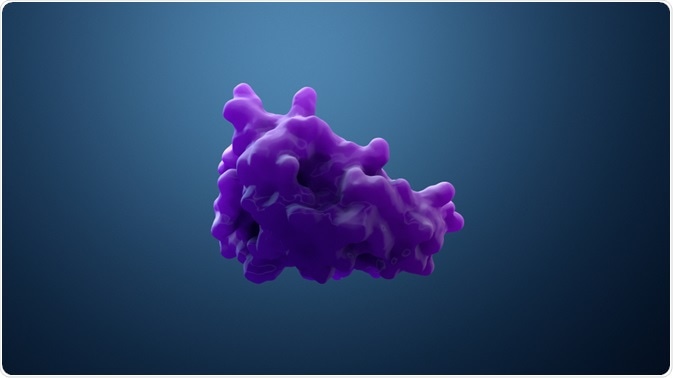Intrinsically disordered proteins (IDPs) can be challenging to identify and study due to their characteristic lack of structure. Bioinformatics techniques have been developed to predict whether a protein may have a disordered structure based on its amino acid structure. Still, analytical methods are required to confirm the protein is an IDP and NMR is emerging as a useful tool for research in this area.
 Image Credit: StudioMolekuul / Shutterstock.com
Image Credit: StudioMolekuul / Shutterstock.com
Until recently, biologists believed that all functional proteins undergo a folding process that gives them a unique conformation, enabling them to carry out their intended biological processes. The link between amino acid sequence, three-dimensional structure, and functions of biological proteins has been the central dogma of structural biology for decades.1
However, in recent years, several genome projects have uncovered the importance of biological proteins that do not adopt specific folded structures under physiological conditions. This class of proteins, known as intrinsically disordered proteins (IDPs), has been drawing attention as researchers work to understand what they are, what they do, and how we can exploit their properties.1
What are Intrinsically Disordered Proteins (IDPs)?
Recent studies suggest that disorder in proteins are much more common than the traditional structural biology dogma may lead us to believe, with around 33% of eukaryote proteins predicted to contain disordered segments.1,2
Intrinsically disordered proteins are a large class of flexible proteins with no tertiary structure under biological conditions and very little secondary structure. The amino acid sequences of IDPs differ from structure proteins.
They contain amino acids that promote disorder, such as hydrophilic and charged amino acids, like alanine, arginine, glycine, glutamine, serine, proline, glutamic acid, and lysine. As a result, these proteins are often hydrophilic and charged, giving them different functional properties compared with structured proteins.1,2
Characterizing Intrinsically Disordered Proteins with NMR
The first step to understanding intrinsically disordered proteins is identifying them. Their disordered nature means that these proteins can be difficult to identify using traditional protein characterization methods such as X-ray crystallography.
NMR has emerged as a popular solution for identifying and characterizing IDPs, as it can be conducted under physiological conditions and provides information about the residual structure, protein function, and protein dynamics.3,4
NMR spectra of IDPs have characteristic features. The polypeptide chains of IDPs rapidly convert between multiple conformations, resulting in poor dispersion in 1H-NMR spectra, with signals clustered around the 8.0-8.5 ppm region. In contrast, 1H spectra of structured proteins show much more dispersion, with chemical shifts ranging from 6.50-10.0 ppm.1,3,4
Comparing the dispersion of chemical shifts in 1H spectra provides an easy way to confirm that a protein is disordered. Assigning resonances requires multidimensional NMR, with researchers typically obtaining 2D heteronuclear single quantum coherence (HSQC) spectra when investigating IDPs.1,3,4
Do Intrinsically Disordered Proteins have common properties?
The large number of intrinsically disordered proteins found within the human proteome suggests that they may have many vital functions within our bodies. Although no common functions have been identified so far, IDPs have been found functioning as molecular chaperones, preventing protein aggregation, solubilizing aggregated proteins, and reverting misfolded proteins to their native structure.1,2
Dehydrins are a class of IDPs that have been well researched recently due to their cryoprotective properties, making them potential additives to increase the stability of biopharmaceuticals during storage.
Sericin, another IDP, also has cryoprotective properties. However, the amino acid sequences of both of these IDPs are unrelated, leading to the question: Do all IDP have cryoprotective properties? A group of researchers from Japan conducted a study to find out.2

Image Credit: Design_Cells / Shutterstock.com
Identifying Intrinsically Disordered Proteins and studying their cryoprotective properties
The researchers, whose work was published in the International Journal of Molecular Sciences, used bioinformatics to identify potential IDP(s) from human genome databases. They then randomly selected six likely intrinsically disordered proteins and expressed them. They used 1H-15N NMR to confirm whether the expressed proteins were disordered before investigating their cryoprotective and lyophilization properties.2
The team obtained HSCQ spectra of the potential IDP using an Avance III 600 MHz NMR spectrometer from Bruker. The spectra they obtained confirmed that five of their six predicted IDPs showed characteristic clustering of the 1H chemical shifts between 7.6 and 8.6 ppm, demonstrating their disorder. They concluded that the remaining candidate was partially folded.2
When they investigated the properties of the five confirmed IDP(s), they found that they all demonstrated cryoprotective properties, despite having unrelated amino acid sequences.
Cryoprotectant proteins derived from human-genome sequences offer a significant advantage over other cryoprotectant proteins as they do not cause an immunological response, meaning they are suitable for medicinal use.2
There are many more IDPs that have not yet been identified or researched. NMR will undoubtedly play an essential role in investigating these protein types and exploiting their properties.
References
- ‘Structure and Function of Intrinsically Disordered Proteins’ —Tompa P, Fersht A, CRC, 2009.
- ‘Discovery of Cryoprotective Activity in Human Genome-Derived Intrinsically Disordered Proteins’ — Matsuo N, Goda N, Shimizu K, Fukuchi S, Ota M, Hiroaki H, International Journal of Molecular Sciences, 2018.
- ‘Application of NMR to studies of intrinsically disordered proteins’ — Gibbs EB, Cook EC, Showalter SA, Archives of Biochemistry and Biophysics, 2017.
- ‘NMR contributions to structural dynamics studies of intrinsically disordered proteins’ — Konrat R, Journal of Magnetic Resonance, 2014.
About Bruker BioSpin - NMR, EPR and Imaging
 Bruker BioSpin offers the world's most comprehensive range of NMR and EPR spectroscopy and preclinical research tools. Bruker BioSpin develops, manufactures and supplies technology to research establishments, commercial enterprises and multi-national corporations across countless industries and fields of expertise.
Bruker BioSpin offers the world's most comprehensive range of NMR and EPR spectroscopy and preclinical research tools. Bruker BioSpin develops, manufactures and supplies technology to research establishments, commercial enterprises and multi-national corporations across countless industries and fields of expertise.